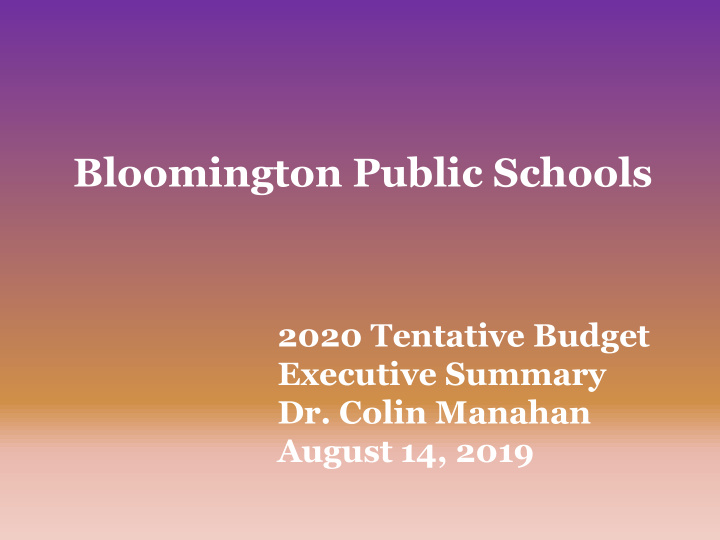



Bloomington Public Schools 2020 Tentative Budget Executive Summary Dr. Colin Manahan August 14, 2019
Board Financial Goal - #5
Agenda FY19 In Review Budget & Levy Calendar Budget Principles Budget Assumptions FY20 Budget Overview
FY19 in Review
Fy19 IN REVIEW Amended Legal Budget
Fy19 IN REVIEW Unaudited Actual Results
Fy19 IN REVIEW Budgeted Gap Analysis
Fy19 IN REVIEW ESSA Reporting
Budget & Levy Schedule August 14, 2019 – Develop and present the FY20 tentative budget. September 25, 2019 – Public hearing and approve the FY20 legal budget October 23, 2019 – 2019 Levy report for 2021 budget. December 11, 2019 – Levy hearing and approve 2019 Levy. January/July 2020 – Develop 2021 budget principles and outlook. March/May 2020 – Review status of 2020 budget and 2021 RIF. May/June 2020 – Amend FY20 budget if necessary.
Budget Principles Maintain the fiscal health of the district. Maintain a multi-year view. Target resources to maximize academic achievement. Equitably fund the entire K-12 academic program. Assure the safety of students and staff at all schools.
Budget Assumptions Local Revenue is down EAV decline of .70% (two years in a row of declining EAV). Property tax revenue down $291,197. CPPRT is estimated to be flat (3-year average). State Revenue is down Evidence based funding model – hold harmless from FY19 funding levels. Delay in MCATS, FY18 received in FY19 inflated FY19 revenue. Remaining MCAT revenue significantly down in FY20. Federal Revenue is slightly up Certified Staff and Paraprofessionals Salaries Per BEA and BESP negotiated contracts. Healthcare costs Premium increase of 2.3%.
FY20 Budget Summary Transfer of $1,340,000 from the Working Cash Fund to the Education Fund to maintain minimum Education Fund Balance of $12,000,000. Transfer of $160,000 from the Working Cash Fund to the Operations & Maintenance due to declining fund balance.
FY20 Budget Summary Salary increases for BEA and Program Assistants per negotiated contracts. BEA Contract – 1 year left. Paraprofessionals contract – 5 years. Salary adjustment recommendation for Administrators & Directors, Professional Supervisors, Food Service, and OTE Staff. Structural deficit of $2,021,313. All revenue sources projected to be down $1,512,681 (-2.32%). All expenditure sources projected to be up $1,148955 (+1.78%). CPI averages 2.0%.
EAV – What is Known From 2016 to 2017, an EAV decline of .25%. From 2017 to 2018, an EAV decline of .70%
Property Taxes – What is Known Levy, Fall of 2018 Extension, Spring of 2019 Collection Rate Estimated at 99.5%. Total decrease in revenue, FY19 to FY20 is $291,197, a decline of .67%.
CPPRT – What is Known No consistent trend in funding. Total Revenue was up 8.2% from FY18 to FY19 (+$323,374). Past three-year average, estimated total revenue for FY20.
Other Local Revenue Total Other Revenue = $4,391,952. Down for FY20 because of reduced Working Cash transfer to the Education Fund.
State Contributions In 2018, Evidence Based Funding replaced General State Aid Funding for FY20 held harmless from FY19 revenue amounts. FY20 = $8,438,648 (+$160,000). This rolled (5) categories into Evidence Based Funding: General State Aid Bilingual Ed Spec Ed Personnel Spec Ed Pupil (Child Funding/Extraordinary) Spec Ed Summer School
State Contributions Special Education Special Education Funding: Trending downward on funding over the course of the past five years. Significant decrease in FY19 & FY20 because majority of prior MCAT’s were rolled into Evidence Based Funding. Typically receive 4 payments. Received 5 payments in FY16 (explains the spike).
Federal Contributions FY19 Federal Revenue = $5,991,414 Special Education Title Grants Food Service FY18 spike in revenue because Medicaid reimbursement up, IDEA up, and Food Service up. Federal revenue projected to be slightly up with the addition of a $200,000 school improvement grant
FY20 Total Revenue Breakdown
FY20 Total Expenses Breakdown
FY20 Total Expenses Breakdown
Future Issues in Funding Local Property Tax Revenue – EAV down the past two years. CPPRT – Trend is flat and unpredictable. Potential legislative changes. Minimum Teacher salary of $40,000 starting 2022-23 school year. Minimum wage increases to $15.00 per hour on January 1, 2025. Federal funding uncertain for Title Grants.
FY20 Budget Summary Transfer of $1,340,000 from the Working Cash Fund to the Education Fund to maintain minimum Education Fund Balance of $12,000,000. Transfer of $160,000 from the Working Cash Fund to the Operations & Maintenance due to declining fund balance.
Questions
Recommend
More recommend